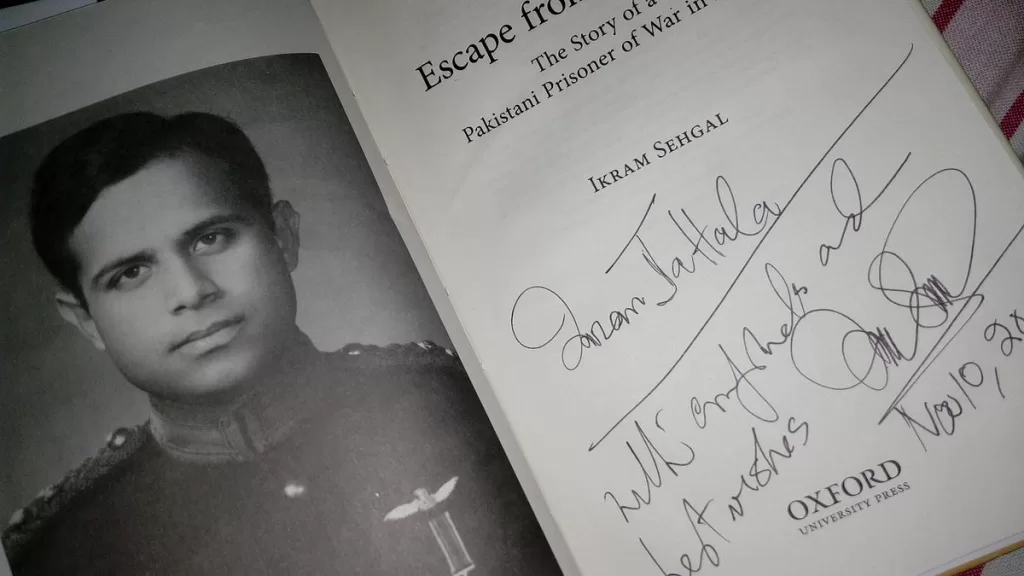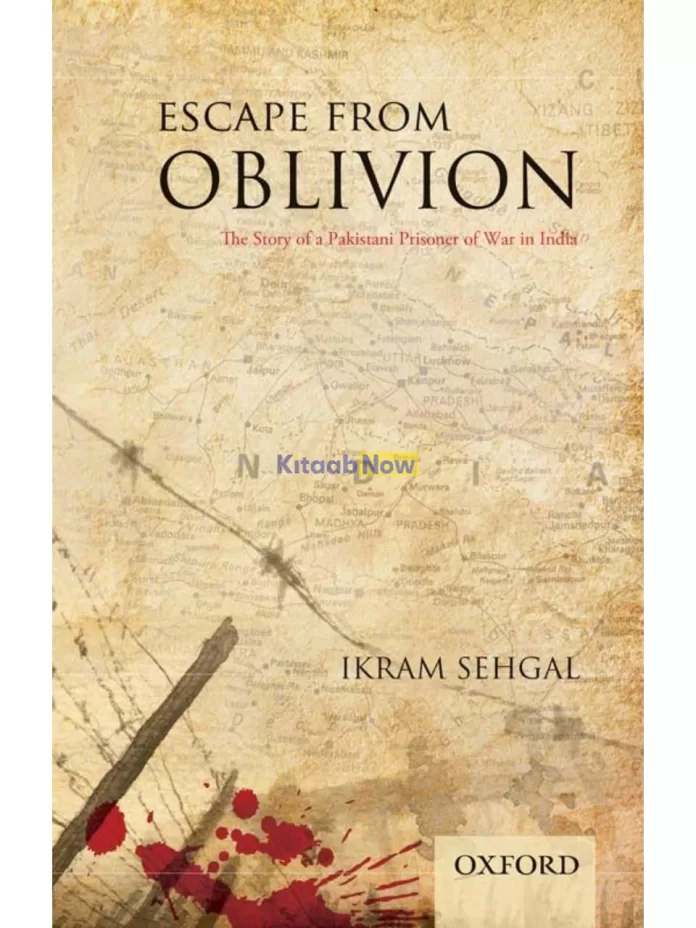Ikram Sehgal’s memoir reads more like a racy suspense novel instead of a gritty, soldierly chronicle and in his fore-ward to the book, Air Marshal (retd) Asghar Khan is right to comment that this fascinating account would make an excellent film. Sentences such as “I have gone through an odyssey and yet I am no Ulysses,” and “I had a date with destiny which I could not avoid,* are really more in line with fiction than the real-life record of a POW escape. But on the upside, a melodramatic script-like prose full of idiomatic language and sprinkled liberally with proverbs is what makes Sehgal’s account immensely readable. Also, Sehgal’s narrative is chronologically adept and there are no loose ends to confuse the reader. Geographical details are also carefully provided. A huge cast of characters aid his story and Sehgal care-fully portrays the behaviour and traits of fellow officers. He is also clever at combining the personal with the political, especially with regard to his fore-most dilemma: his father was a Punjabi and his mother a Bengali.
Sehgal was nearly 25 years old when he escaped from an Indian Prisoner of War (POW) camp in Panagarh, West Bengal. It was July 1971 and war had not broken out between the two wings of a united Pakistan, but the Pakistani All military had already cracked down in Dhaka in March, to curb the growing insurgency in East Pakistan. Sehgal was an army aviation pilot in the 2 East Bengal Regiment, an infantry unit that had been raised by his father in 1949. On March 27, 1971 he arrived in Dhaka on a posting to Logistic Flight Eastern Command. A day later, 2E rebelled and several Bengali officers murdered their West Pakistani col-leagues — the core of the rebellion occurred in regiments such as 2E, which was considered totally Pakistani, but comprised largely Bengali personnel. The time is out of joint and Sehgal de-scribes his trepidation with emotion and fear — a revolt of loyalties, a regiment out of sync, and now as a West Pakistani officer, his life was at stake. Sehgal’s overview of disintegrating nationhood is carefully encapsulated in his experiences of that tenuous period. Sehgal made his way from Dhaka to his parent regiment to find out that the al-legations about his regiment were true — his worst imaginings had been re-placed with a reality that almost defies humanity. And from thereon began his escape odyssey, for soon Sehgal would be at the mercy of the Indian authorities. Sehgal describes the harrowing details at length — interrogation by the Indian Border Security Force and intelligence, three weeks spent in custody at Agartala jail, a run-in with captured tea-planters and their families, an encounter with Charu Majumdar, a leader of the Naxalites, his departure from Agartala airport in a Dakota airplane with fellow West Pakistani officers and the description of the flight from Agartala to Panagarh Civil Airport. The details of these interactions provide insight into what actually happened on a day-to-day level in unit and regiment. Sehgal also says he was a “living witness to the direct interference of the Indians in the internal affairs of Pakistan.” The Indians, he believes, were allergic to Zulfikar Ali Bhutto and immensely worried about China’s sway over Pakistan. After Agartala, Sehgal was taken to the Panagarh POW camp.
Sehgal first describes his escape in his prologue to the book. Panagarh, where the POW camp is located, is just off the Grand Trunk Road (G.T Road) between Calcutta and Bihar. A rather rudimentary map is avail-able in the book; publishers should make note of the necessity of detailed maps — a fundamental need of any account of military history.
Sehgal spent 99 days in the camp and decided that either he would escape or get killed — there would be no second chances. The escape from Panagarh involved re-search and thought: Sehgal had to study the layout of the camp, know the habits of the sentries and possible routes out of the camp. His description of the escape and his journey to Calcutta — carefully embellished with a hitchhiking experience — are dramatic to say the least. Sehgal chose Calcutta because he remembered the address of a lady he knew there — when he made his way to her address he was shocked to find that there was no Zeenat Hamid at 8, Royt Road. In his signature style he admits that he was “a destitute optimist at large in Calcutta city.” Sehgal was also immensely disappointed with the 1971 Calcutta: a filthy, teeming metropolis on the east bank of the Hooghly River.
He decided to try his luck with the Americans, and beat a path to their consulate in Calcutta. The Americans gave him sanctuary and Sehgal struck up a friend-ship with a Sergeant Frank Adair of the US Marines, the guard on duty that night and felt that they were “two young men brought together by a quirk of fate.” Sehgal also makes interesting observations on the inner workings of the CIA through his encounters with embassy staff in Calcutta in 1971. Later, he kept in touch with the “cold and calculating” Charles Coudert, the CIA official who interrogated him when he arrived at the US Consulate in Calcutta in July 1971, as well as Paul Thibault, a real smooth operative who impressed Sehgal with his charm and with whom he shared a common interest in books and music.

The Americans only kept Sehgal provisionally, a reason he attributes to Kissinger’s successful visit to China that year abetted by the offices of General Yahya Khan. Pakistan was in America’s good books but they were not ready to counter any Indian allegations or cause a diplomatic furore. Sehgal was on his own again, albeit a few hundred rupees richer. Tension to move was on the rise once more and Sehgal took a flight to Delhi, moved from Delhi to Bhairhawa, from where he flew to Kathmandu posing as the manager of a tea-estate in Sylhet. In Nepal, he posed as a stranded Pakistani business-man. In the final leg of the escape he took a Burma Airways flight to Rangoon, aided by the PIA station manager in Kathmandu, with an onward connection to Bangkok. And once again, true to style, he encapsulates his plan succinctly, “I had run silent from Calcutta to Delhi. From Delhi to Kathmandu I had to run deep.”
Sehgal spent 99 days in the camp and decided that either he would escape or get killed — there would be no second chances. The escape from Panagarh involved re-search and thought: Sehgal had to study the layout of the camp, know the habits of the sentries and possible routes out of the camp. His description of the escape and his journey to Calcutta — carefully embellished with a hitchhiking experience — are dramatic to say the least
All along this momentous journey, Sehgal met several people who aided and abetted his escape plan — some with whom he forged strong bonds. In Bangkok, he outlines a conversation with the PIA station manager, Col Mujeebur Rahman, whose views encapsulate how several West Pakistani officers were racially motivated with parochial views — ” it was clear that my Pakistan was dead,” says Sehgal. And after his escape ordeal he arrived back in Dhaka to ask, “Was East Pakistan home in August 1971?” The first draft of Sehgal’s escape story was written during interrogation at HQ of Inter-Services Screening Committee (ISSC) in Dhaka in 1971. He spent 84 days in custody for interrogation.
Sehgal’s book is a detailed chronology of an escape as well as a personal memoir recording his innermost thoughts. He understood that to carefully implement his plan he had to be rational, analytical and logical, keep his emotions in check, not be led by his instincts, and show a lot of patience concluding with a final thought that, at the end, the incentive to escape was everything. Since Sehgal was a military man, he exercised sound military judgment most of the time, but he was, more often than not, led by personal motivations, which is very evident in the book. Escape from Oblivion is not a compendium of a military experience: it is a personal saga transformed into a story well-told..





